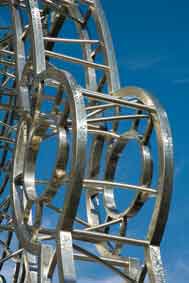
 Unveiled just three days from the start of the Melbourne 2006 Commonwealth Games, the 10 sculptures are a tribute to multiculturalism.
Unveiled just three days from the start of the Melbourne 2006 Commonwealth Games, the 10 sculptures are a tribute to multiculturalism.
Each of 'The Travellers' figures represents a period from our Indigenous and immigrant histories (as defined by historian Dr James Jupp) and were designed by Lebanese Artist, Nadim Karam of Atelier Hapsitus.
'Gayip - The Aboriginal Period', the first sculpture, is stationed permanently on the river bank to depict the Indigenous owners of the area who were here already.
Nine of the 10 sculptures cross the river three times a day on a fixed bogie system to represent stages of migration in Australia's history from the convict and gold rush periods through to European and refugee settlement.
More than 3.7 km of stainless steel (in 4455 pieces) was used to create the sculptures.
ASSDA member, Silverstone Engineering fabricated the majority of the 10 sculptures from grade 316 stainless steel supplied by ASSDA Major Sponsors, Sandvik Australia Pty Ltd, Atlas Steels and ASSDA Member, Midway Metals Pty Ltd.
 The remaining stainless steel sculptures were fabricated by Danfab, JW Metal and Able Engineering.
The remaining stainless steel sculptures were fabricated by Danfab, JW Metal and Able Engineering.
Stainless steel rectangular hollow sections were used on the outer frames. The inner rails were made of pipe and bar. Some of these rectangular hollow sections were inductarolled (rolled after heating by using an induction furnace) by Melbourne company, Inductabend, with a discoloured zone or heat band running around the material.
The sculptures required much tighter radii than had previously been delivered, and Inductabend's equipment was pushed to its limits when bending the steel sections.
Following fabrication, the sculptures were then polished to 0.4 Ra, cleaned and then passivated to ensure high corrosion resistance.
Originally built in 1888 by David Munro, the Sandridge Bridge is considered one of the earliest examples of steel girder bridge construction in Australia.
The $3 million 'Travellers' sculptures project was part of an $18.5 million Sandridge Bridge Precinct development funded by the City of Melbourne and the State Government that includes a new pedestrian bridge, a plaza and a youth precinct on the north bank.
This article featured in Australian Stainless Issue 36, Winter 2006.